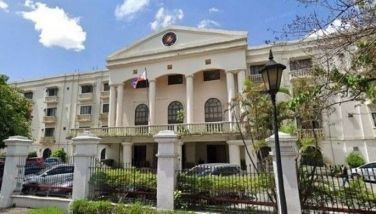Government prepares for Bali-type disasters
November 16, 2002 | 12:00am
The National Disaster Coordinating Council (NDCC) has set up a 24-hour quick reaction center to respond to any natural and man-made disasters, such as earthquakes or terrorist bombings.
The NDCC quick reaction unit is composed of a disaster response company, reservists and volunteers equipped with state-of-the-art search and rescue facilities, according to NDCC head retired Maj. Gen. Melchor Rosales.
"Our unit is capable of responding to rescue people trapped in collapsed buildings due to natural or man-made calamities," Rosales told the weekly Balitaan sa Rembrandt Hotel forum in Quezon City.
The quick reaction unit is equipped with lifting bags that can raise up to 70 tons of concrete slabs in collapsed buildings.
They can also mobilize ambulances and fire trucks from different local government units all over Metro Manila should disaster strike. Makati and Marikina cities have their own disaster reaction units.
Rosales, however, said that NDCC is just a coordinating agency and in the aftermath of disasters, the city or municipal mayors will be in full control of search and rescue operations, as provided for in Presidential Decree 1566.
In disasters of "catastrophic" proportions, the Department of Social Welfare and Development will handle evacuation and relief of victims, the Department of Health will take care of emergency medical assistance, while the Department of Public Works and Highways is tasked with emergency reconstruction of damaged roads and streets.
"But command and control will be the main duty of the local chief executives, just what Mayor Giuliani in New York did during the Sept. 11 terror attack," Rosales said.
Since the Philippines is located within the earthquake belt and often beset by typhoons, the NDCC has regular monthly meetings to update its members on the disasters that may hit the country.
Rosales said the possibility of a bomb attack similar to the incident in Bali, Indonesia which killed nearly 200 people, was a top concern in a recent council meeting.
The NDCC is also monitoring 22 active volcanoes and preparing for 22 typhoons – as well as monsoon rains that sometimes trigger flash floods in various parts of the country. Earthquakes may happen at any time.
To deal with these calamities, the NDCC is observing four P’s – predict, prevent, prepare, and perform – Rosales said.
Government agencies such as the Philippine Institute of Volcanology and Seismology and the weather bureau forecast natural phenomena, while the Philippine National Police and the military gather intelligence information about possible terrorist action.
The government can then prevent disasters by neutralizing terrorist threats or preparing contingency measures for any eventuality. After disaster strikes, government agencies are ready to perform their mandated tasks.
"We can always predict and prepare but we really don’t know when the disaster will happen," Rosales said.
The NDCC quick reaction unit is composed of a disaster response company, reservists and volunteers equipped with state-of-the-art search and rescue facilities, according to NDCC head retired Maj. Gen. Melchor Rosales.
"Our unit is capable of responding to rescue people trapped in collapsed buildings due to natural or man-made calamities," Rosales told the weekly Balitaan sa Rembrandt Hotel forum in Quezon City.
The quick reaction unit is equipped with lifting bags that can raise up to 70 tons of concrete slabs in collapsed buildings.
They can also mobilize ambulances and fire trucks from different local government units all over Metro Manila should disaster strike. Makati and Marikina cities have their own disaster reaction units.
Rosales, however, said that NDCC is just a coordinating agency and in the aftermath of disasters, the city or municipal mayors will be in full control of search and rescue operations, as provided for in Presidential Decree 1566.
In disasters of "catastrophic" proportions, the Department of Social Welfare and Development will handle evacuation and relief of victims, the Department of Health will take care of emergency medical assistance, while the Department of Public Works and Highways is tasked with emergency reconstruction of damaged roads and streets.
"But command and control will be the main duty of the local chief executives, just what Mayor Giuliani in New York did during the Sept. 11 terror attack," Rosales said.
Since the Philippines is located within the earthquake belt and often beset by typhoons, the NDCC has regular monthly meetings to update its members on the disasters that may hit the country.
Rosales said the possibility of a bomb attack similar to the incident in Bali, Indonesia which killed nearly 200 people, was a top concern in a recent council meeting.
The NDCC is also monitoring 22 active volcanoes and preparing for 22 typhoons – as well as monsoon rains that sometimes trigger flash floods in various parts of the country. Earthquakes may happen at any time.
To deal with these calamities, the NDCC is observing four P’s – predict, prevent, prepare, and perform – Rosales said.
Government agencies such as the Philippine Institute of Volcanology and Seismology and the weather bureau forecast natural phenomena, while the Philippine National Police and the military gather intelligence information about possible terrorist action.
The government can then prevent disasters by neutralizing terrorist threats or preparing contingency measures for any eventuality. After disaster strikes, government agencies are ready to perform their mandated tasks.
"We can always predict and prepare but we really don’t know when the disaster will happen," Rosales said.
BrandSpace Articles
<
>
- Latest
- Trending
Trending
Latest






























